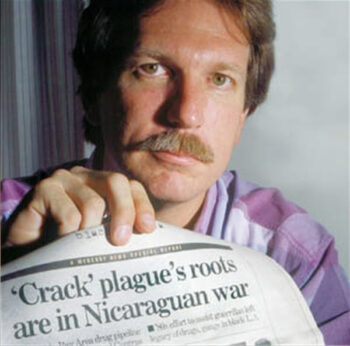by BELEN FERNANDEZ

Twenty years ago this month, on December 10, 2004, former San Jose Mercury News investigative reporter Gary Webb died by apparent suicide, following a stretch of depression. The subject of the 2014 film Kill the Messenger, Webb had left the newspaper in 1997 after his career was systematically destroyed because he had done what journalists are supposed to do: speak truth to power.
In August 1996, Webb penned a three-part series for the Mercury News (8/18–20/96) that documented how profits from the sale of crack cocaine in Los Angeles in the 1980s had been funneled to the Contras, the right-wing, CIA-backed mercenary army responsible for helping to perpetrate, to borrow Noam Chomsky’s words, “large-scale terrorist war” against Nicaragua. At the same time, the crack epidemic had devastated Black communities in South Central LA—which meant that Webb’s series generated understandable uproar among Black Americans across the country.
But Webb’s revelations should hardly have been a newsflash. As FAIR’s Jim Naureckas (10/21/14) noted in a 2014 dispatch, the CIA was informed
as early as September 1981 that a major branch of the Contra “leadership had made a decision to engage in drug-smuggling to the United States in order to finance its anti-Sandinista operations,” according to the CIA inspector general’s report.
Not that the CIA was any stranger to drug-running—as indicated by, inter alia, a 1993 op-ed appearing in the New York Times (12/3/93) under the headline “The CIA Drug Connection Is as Old as the Agency.” The essay traced CIA ties to narco-trafficking back to the Korean War, while the Vietnam War reportedly saw heroin from a refining lab in Laos “ferried out on the planes of the CIA’s front airline, Air America.” The piece went on to emphasize that “nowhere…was the CIA more closely tied to drug traffic than it was in Pakistan” during the Afghan/Soviet war of 1979 to 1989.
Decade-long suppression of evidence
And yet, in spite of such established reality, Webb was subjected to a concerted assault by the corporate media, most notably the New York Times, Washington Post and LA Times, as detailed in a 1997 intervention by FAIR’s Norman Solomon (Extra!, 1–2/97). The media hit job relied heavily on denials from the CIA itself—as in “CIA Chief Denies Crack Conspiracy” (11/16/96), one of the examples cited by Solomon—which is kind of like saying that the bear investigated the sticky goo on his paws and determined that he was not the one who got into the honeypot. In December 1997, the same month Webb left the Mercury News after being discredited across the board and abandoned by his own editors, the New York Times (12/19/97) reassured readers that the “CIA Says It Has Found No Link Between Itself and Crack Trade.”
As Solomon argued, “The elite media’s attacks on the series were clearly driven by a need to defend their shoddy record on the Contra-cocaine story—involving a decade-long suppression of evidence” (Extra!, 7/87; see also 3–4/88). Time and again, the nation’s leading media outlets had buried or obstructed news suggesting Contra-cocaine links; Naureckas (10/21/14) pointed out that the Washington Post
ignored Robert Parry and Brian Barger’s groundbreaking AP article (12/20/85), which first revealed the involvement of Contras in drug-running, and then failed to follow up as smaller papers reported on Contra-related cocaine traffic in their backyards (In These Times, 8/5/87).
As a senior Time magazine editor acknowledged to Laurence Zuckerman, a staff writer whose 1987 story on Contra-related cocaine traffic was ultimately scrapped (Extra!, 11/91) : “Time is institutionally behind the Contras. If this story were about the Sandinistas and drugs, you’d have no trouble getting it in the magazine.”
Fairnes & Accuracy In Reporting for more
